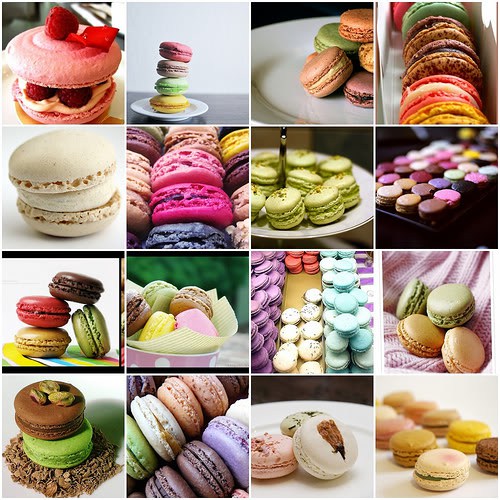
jek in the box {is home}/flickr
Bonjour!
Would you like a macaron? Please help yourself!

mosaic from lildamselfly’s flickr photostream
Small and round, crisp, creamy, so colorful and, let’s face it, so dang cute — you’d have to be hard-hearted indeed to turn down one of these beauties. Before you accuse me of misspelling the name of this French meringue cookie sandwich, let me clarify — le macaron is different from the American macaroon (a sticky, chewy, overly sweet coconut cookie).
The macaron got its name from the Italian word, maccarone, which means “fine paste,” or “fine dough.” Its exact origin is still being debated (some say they were first made at an Italian monastery to resemble monks’ belly buttons). ☺ But most agree the macaron’s French debut occurred in the 16th century with the arrival of Catherine de Medici, who brought her pastry chefs with her upon marrying King Henri II.

Rose macaron by lynac/flickr.
As with most things culinary, the French took the simple almond flour, egg white and sugar confection to new heights, serving them in the 19th century with spices, jams and liqueurs, and then in the 20th century, inventing the sandwich cookie we know today. Credit goes to Pierre Desfontaines of the famous pâtisserie Ladurée, who took two of these meringue discs and filled them with chocolate ganache. Ever since, French pastry chefs have taken great pride in creating new flavor combinations, moving beyond the standard vanilla, chocolate and raspberry, to exotic delights such as matcha tea, rose, mango, and passionate fruit. Today, if you visit most any Paris pâtisserie, you will find trays and trays of marvelous macarons, with fillings made from ganache, buttercream, and various jams.

Chocolaterie Biscuiterie Larnicol in Bordeaux by [(o)].
But “macs,” as they are affectionately called, are so much more than pretty, elegant cookies served with coffee, tea or champagne. Not only are they challenging the cupcake’s popularity as favorite hand-held sweet among foodies in this country, but in Paris they are serious status symbols. In his cheeky blog post, French sommelier Olivier Magny calls the macaron “a key social lubricant in Paris.” Strong stuff for such a little cookie. “While most Parisians have given up on ancestral guilty pleasures (sex, drugs, alcohol), very few will say no to the modern form of socially acceptable vice: Le Macaron Ladurée.”

newyork808/flickr
Well, now. *clicks teeth* We can sin in a socially acceptable manner!
Shall we have a few more?

Macarons at F. Lamet, Paris, by little miss pamplemousse.
We needn’t limit ourselves to Ladurée. Many swear by Pierre Hermé’s macarons, and in Paris Sweets, Dorie Greenspan says we should visit many pâtisseries, and once we have decided on a favorite, name-drop at every opportunity like the native Parisians do.

mosaic by Teka e Fabi®/flickr
But alas, we do not live in Paris. Not to worry, macarons have been making steady inroads in the States, showing up at fancy dinner parties and in hotel restaurants, appearing like privileged guests at upscale pastry shops in major cities like New York, Chicago, and Los Angeles. They can also be ordered online through well-known sites like MadMac or Michel Patisserie. Because they are difficult to make at home, and as yet, not widely available, they have acquired a certain snobbishness about them.

Pimoo/flickr
Some say they will never gain the cupcake’s wild popularity, and that may very well be true, since in America, cupcakes will always engender fond childhood memories; they cut across class lines and can be dressed up or down, according to the occasion. Still, macarons have much going for them: Americans are, if nothing else, shamelessly status conscious, and even in tough economic times, do not seem to be depriving themselves of sweet rewards.
Foodies love the seemingly endless varieties and possibilities, the allure of something exclusive, the dreamy, fairytale-like quality of a well-made macaron. With its fascinating history (I like the story of the “macaron sisters,” two Benedictine nuns from Nancy who supported themselves during the French Revolution by baking and selling them), irresistible cuteness, compact size and shape, and ease of consumption (no messy frosting or fussy toppings like some cupcakes), the macaron might just surprise everyone.

jek in the box {is home}/flickr
As for me, I’ve just placed my first order for a sampler box from Michel Patisserie, which is based in Arlington, Virginia. They provide macarons for local establishments in the D.C. area and also ship nationwide. I can’t wait to try them, and will definitely share my reactions. Stay tuned for a mac attack!
Copyright © 2010 Jama Rattigan of jama rattigan’s alphabet soup. All rights reserved.

One thought on “a dream of macarons”
Comments are closed.